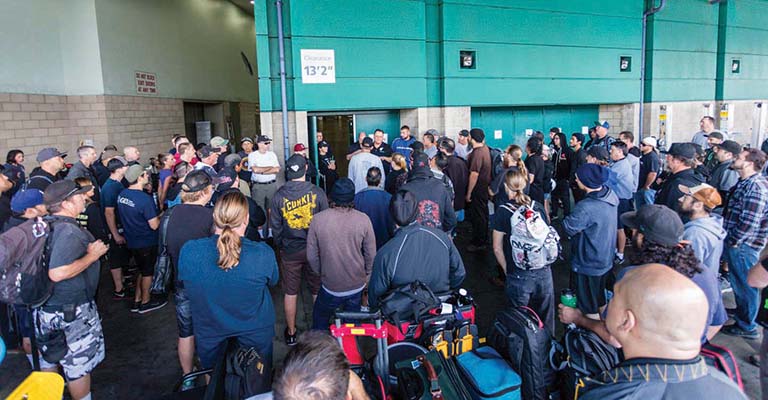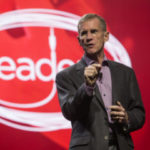
Last month, the LA Auto Show celebrated its 110th anniversary. The show’s journey along the highway of growth and innovation has earned it must-attend status from the CEOs of leading car brands and everyday auto lovers alike. The New York Times, Forbes, USA Today, and a range of other publications regularly praise the program for its display of next-generation technology.
With a footprint bigger than 870,000 square feet, the LA Auto Show takes over the entire Los Angeles Convention Center, stretching outside with an additional pavilion for the four-day, B2B-focused AutoMobility LA event, which precedes the 10-day consumer show. Hundreds of thousands of attendees, exhibitors, and other participants from 58 countries can see debuts from top names in automotive innovation, take test drives, and preview the future of moving from here to there.

But attendees aren’t the only ones with plenty of ground to cover. Before and after the doors are open to visitors, Terri Toennies is doing a lot of walking. Over the 24 days she was on site for the 2016 LA Auto Show, Toennies — executive vice president and general manager of ANSA Productions, which owns and operates the show — logged 160 miles on her FitBit as she regularly walked the perimeter to verify that security personnel were in their proper positions. It’s an issue that increasingly weighs on the minds of meeting professionals in the wake of terror attacks and mass shootings in crowded public gathering places.
When Convene recently caught up with Toennies, she had just purchased four new pairs of shoes for the 2017 show, which was held on Dec. 1–10. As she prepared to lace up for another year of automotive innovation, Toennies offered her thoughts on the evolving state of event security — including why every event organizer needs to be in the driver’s seat when it comes to attendee safety.
How have the security measures at the LA Auto Show evolved in recent years?
I joined the team [at ANSA Productions] in October 2012, and I had spent a large portion of my career in venue management, working at the House of Blues in New Orleans and helping to open the location in Las Vegas. Directly before coming to Los Angeles, I was the president, CEO, and general manager of The Oncenter in my hometown [Syracuse, New York], where I gained even more experience in crowd control and crowd management.
When I arrived, I realized that the entertainment business is a lot farther ahead than business events and trade shows from a security perspective. At that point, we checked bags on press days, but the team wasn’t looking for explosives. They were more worried about protesters from auto unions. Now, there are much bigger threats confronting events. It’s just the way the world is today. In 2014, we brought in an outside consultant to help assess our security measures, and by 2015, we added metal detectors and bag checks for everyone coming to the show.
How big is the security team?
We are a big platform, and our staff varies between 200 and 250 personnel throughout the building. We work closely with the L.A. Convention Center staff, and we consider them part of our team. They have approximately 300 cameras that are monitored 24 hours a day, seven days a week. In addition to the built-in network of security personnel, we hire off-duty officers from the Los Angeles Police Department. These are officers who work in the Central Division. They know if there is something buzzing or if something is going on outside that we should be aware of in the convention center. They loyally work for us and take time off from their jobs during the show to become an extension of our team.
What’s the timeline of the security process look like?
Our security begins during move-in with perimeter [personnel] and the K-9 units. Then, it progresses to exhibitor security, our ambassador program, Los Angeles Police Department, [California] Department of Transportation, and California Highway Patrol — as we move from the business trade show to the consumer show to move-out. We work closely with the convention center’s security team to know who controls an emergency situation or a threat. Throughout the show, we have regular meetings so that everyone is on the same page.
What does all of this cost?

There’s no question that securing a big venue is an expensive venture, but it’s important to recognize that there are opportunities to cover some of the additional costs. For example, some manufacturers hire additional security personnel for their individual booths, but they hire those workers through the show. [With an additional fee that goes to the show,] it’s a revenue source that allows us to add our K-9 units.
Last year, we launched a new ambassador program, too, that wound up turning into a win-win: a sponsorship opportunity and a security enhancement. The ambassadors come from a background of delivering VIP-level service for green-room security for big recording artists. They are polished hospitality professionals who can deliver real service for guests looking for general building information and assistance navigating the show, but they’re also trained in the see-something, say-something approach. So, in addition to helping our guests, we know we can count on them to add an extra layer of safety.
We found a brand that wanted to put the team in shirts for additional recognition on the consumer days. We had about 25 of them in the lobby areas. The only downside was that attendees weren’t as aware of them because they weren’t wearing LA Auto Show shirts. In the future, we’ll look to add official branding to make sure it isn’t confusing.
Some event organizers may worry that additional security measures might make attendees feel uncomfortable. How would you advise them on the importance of adding these measures?
The public now expects these measures. We go through them at concerts and airports, and the reality is that we should go through them at trade shows and conventions, too. Our exhibitors and sponsors have asked us what we’re doing for security, and they offer us perspectives on what measures they’ve seen at other shows that have worked. They’re happy to know that this is at the top of our priority lists.
Consumer attendees don’t mind, either. When we implemented a new policy last year that placed a size restriction on bags, we were worried that we would face a lot of frustration. So we made sure that everyone who bought a ticket knew about the change with email messaging and updates on the website. And for those who missed the communication, we offered complimentary lockers on site, so that if someone had walked four blocks with a baby’s backpack, they wouldn’t have to turn around. We received zero complaints from hundreds of thousands of attendees.
Is there a security risk that you feel today’s trade-show environment is struggling to address?
I’ve been thinking a lot lately about the employees that we don’t really know. During move-in, we can have up to 1,600 day laborers who are helping with catering, decorating, and other responsibilities in the venue. We all need to look at how we control those union employees who are hired specifically for the event — the sub-subcontractors. Some of them are bringing toolkits, backpacks, and crates. This year, we hired additional K-9 units to roam throughout the move-in process, and we are implementing random security checks, too.
How often do you review your security measures?
This is always evolving. We sit down with all our team members sometime in the first quarter to contract for the following year. There are simple adjustments we make, too. For example, in my first year, I realized that our scheduling chunks were leaving a small window where some areas might be left unguarded, so we double-booked some increments to make sure that everyone could be where they needed to be. It’s not perfect, and it never will be. But it’s something that every organizer should be evaluating. No matter how big or small, this issue affects all of us. It should be a top priority for every meeting, show, conference, and event.
Learn more about the LA Auto Show’s bag policy.



